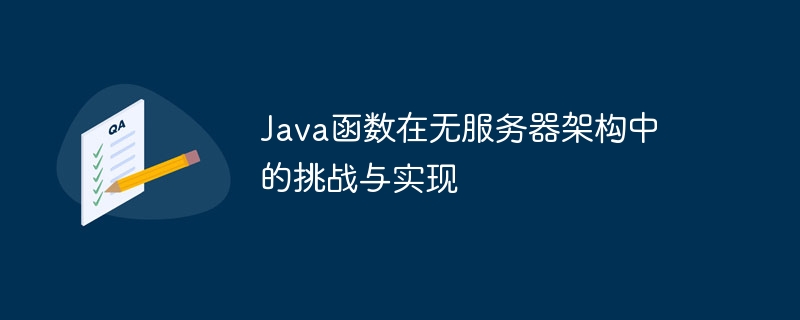Home >Java >javaTutorial >Challenges and implementation of Java functions in serverless architecture
Challenges and implementation of Java functions in serverless architecture
- 王林Original
- 2024-04-26 18:06:011080browse
Challenges with Java functions in serverless architectures include cold start penalties, memory limits, and garbage collection overhead. Implementation techniques include: preheating mechanism, minimizing code, using off-heap memory, adjusting heap size, disabling parallel collector, using weak references and manual cleanup. Practical example: Use AWS Lambda to create and deploy a Java function that returns "Hello World".

Challenges and Implementation of Java Functions in Serverless Architecture
Serverless architecture simplifies cloud computing by decomposing applications into stateless functions. However, there are some unique challenges and implementation techniques for functions written in Java.
Challenge
- Cold start penalty: Java functions will encounter a cold start delay when starting, which slows down the response time.
- Memory Limits: Serverless functions are subject to memory limits, which can limit the size and complexity of Java applications.
- Garbage collection overhead: Java's garbage collector can have an impact on performance, especially in high-throughput workloads.
Implementation tips
Optimize cold start:
- Use preheating mechanism:Before the function They are triggered periodically when called to keep the JVM alive.
- Minimized code: Include only necessary Java dependencies and libraries to reduce initialization time.
Manage memory limits:
- Use off-heap memory: Store non-essential objects in off-heap memory area to avoid memory overflow.
- Adjust the heap size: Set the appropriate heap size in the function configuration to meet application requirements.
Mitigating garbage collection overhead:
- Disable parallel collector: Avoid using parallel garbage collector as it may Will increase overhead.
- Use weak references: Use weak references to objects that are no longer needed so that the garbage collector can quickly reclaim them.
- Manual cleanup: Clear resources and objects explicitly when the function completes to reduce garbage collection pressure.
Practical Case
The following is an example of using AWS Lambda to implement a serverless Java function:
import com.amazonaws.services.lambda.runtime.Context;
import com.amazonaws.services.lambda.runtime.RequestHandler;
public class HelloWorldHandler implements RequestHandler<String, String> {
@Override
public String handleRequest(String input, Context context) {
return "Hello World! " + input;
}
}To deploy this function:
- Package Java code into a JAR file.
- Create an AWS Lambda function, selecting the Java runtime.
- Upload the JAR file and configure function settings (for example, memory limits).
- Trigger the function and verify its response.
The above is the detailed content of Challenges and implementation of Java functions in serverless architecture. For more information, please follow other related articles on the PHP Chinese website!

